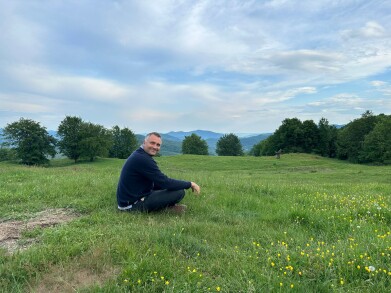Environmental laboratory
‘We can’t restore nature without monitoring’: Ben Goldsmith talks biodiversity, nature recovery and environmental monitoring
Aug 16 2024
Last month, EnvirotechOnline visited the Blue Earth Forum in London, which brought together investors and startups offering solutions in line with the United Nations’ sustainable development goals. Alongside each pitching session, thought leaders and industry veterans took part in panel discussions covering all topics in sustainability and climate tech, from air pollution and soil regeneration to renewable energy and bioplastics.
During the Forum, we got the chance to sit down with superstar environmentalist, philanthropist and investor Ben Goldsmith, co-founder of rewilding services firm Nattergal and Chief Executive of a sustainability investment trust, Menhaden Resource Efficiency PLC. He appeared on a panel discussing the rejuvenation of nature in Britain and abroad, detailing the damage done to ecological integrity by intensive farming and climate change. As an advocate of responsible land stewardship, we discussed the outlook for biodiversity and the role of monitoring in securing healthier, more resilient ecosystems in the UK.
Let’s start with the current government guidelines, regulations and financial incentives to restore biodiversity. What, in your view, are the strengths of our current framework?
We’ve got a pretty good framework in place in this country now for incentivising nature recovery. I mean, I don’t think there are any other countries in the world that have created anything like what’s now coming to bear in the UK. So, you’ve got now an Environmental Land Management scheme, which is a replacement for the old unconditional farm subsidies that were in place for 40 years. That is the only mechanism by which farmers can access public money on a regular basis and in order to do so, they have to deliver public environmental goods. So, that is the principal incentive now for land managers to restore nature and it’s a really, really big one. And in the wake of that – I used the term ‘ice-breaking ship’ in the panel just now – there is a flotilla of new markets which add additional incentives for doing different things. So, for example, natural flood management, in the form of new wetlands and so on, which help store water and release it slowly through the year, that’s something which is being funded by local authorities, by the Environment Agency, by flooding insurers – and linked to that are the nutrient neutrality regulations which enable water companies, developers and so on to pay for the service of removing these nutrients from the landscape. So, rewilding and rewetting land now carries an incentive in the form of the natural flood management programme, nutrient neutrality regulations, and then you’ve got this regulated biodiversity credits market, the biodiversity net gain rules and you’ve also got a voluntary market for carbon which is becoming more important every year. So, the buzzword in land management is ‘stacking’ - anyone with a bit of land that isn’t particularly good for producing food or which isn’t suitable for house-building is now considering how best to optimise a stack of revenues arising from natural capital. So, for the first time an economic value is being placed on healthy vibrant nature and the services it provides and that is simply revolutionary, it’s a massive change.
But in order to understand the natural capital on each piece of land, you have to have monitoring capability and that I think is really interesting, especially around biodiversity. I have a piece of land in Somerset, where I’ve raised my family, where I’ve been since I was young, and we are rewilding that land, generating income through some of these incentive schemes. We’re trialing such things as acoustic monitoring technology which works in conjunction with artificial intelligence to tell you what species of birds are in the landscape and in what abundance. We’re about to trial eDNA, where they measure the water in a watercourse to tell you what species of amphibians, fish and invertebrates and so on are in that watercourse. That kind of stuff is absolutely vital, especially in the field of biodiversity credits, where the buyers of the credits want to see an ongoing increase in bio-abundance – and you can only calculate that if you’ve got accurate measurements! So, I think that whilst biodiversity monitoring technology is only one part of nature tech as a category, I think it’s really, really exciting.
Are most of these schemes that you mentioned government-funded schemes or are some of them private?
So, it’s a combination. The principal incentive for restoring nature is now the Environmental Land Management scheme, which is funded by DEFRA. But then there are a combination of publicly-funded and privately-funded markets that operate in addition. So, natural flood management is typically publicly funded by local authorities, nutrient neutrality is typically funded by the water companies and other private sector players, biodiversity net gain and the regulated biodiversity credits which are being traded are exclusively privately funded – it’s developers that are buying these credits. It’s a pretty good example of the public sector and the private sector working hand in glove to incentivise nature restoration. I think that this quite sophisticated framework of incentives is something that the rest of the world’s watching really closely, because every country in the world has signed up to the 30x30 Pledge, which states that countries will restore 30% of land and 30% of sea to a vibrant nature by 2030, but very few countries have figures out how to do that. England, I think, is blazing a trail in creating the incentives that enable that to happen but none of those incentives can happen without monitoring and measurement technology. So, I think there’s a really exciting innovation space opening up and lots of venture capital firms are starting to look at this.
I think there’s also lots of interesting stuff happening around how you actually restore nature, companies like Rainforest Builder that are figuring out the lowest cost way to restore large tracts of tropical rainforests or companies which are using heavyweight drones to restore mangroves, that literally plant mangrove seeds into the mudflats. There’s all kinds of new technology which are slashing the cost of the actual process of restoration.
What do you think the future of these schemes will be? Is it just doing more of them, scaling them up - or are there new schemes that you’d like to see for specific aspects of nature restoration?
I think the schemes can sometimes be too prescriptive in terms of defining what outcomes are desired. Often, we can’t predict with tremendous accuracy what will happen when you allow nature to recover in a place – sometimes the outcomes can be unpredictable, but that doesn’t make them any less desirable for society. There will always be winners and losers, some species will surge in abundance and some will not do so well but I don’t think we should be forcing outcomes, I think we should allow nature to recover in more of a self-willed manner. Therefore, we can probably reduce some of the bureaucratic burden of these schemes, if we take more of an open-minded view in that regard. Also, I think that the principal Environmental Land Management scheme could be more generous with farmers. We’ve got to make sure that farmers have a just transition and are able to stay in the land, doing what they’ve always done and continue to farm, just in a way that is conducive to real nature recovery. If we underfund these schemes, we do them a disservice – and probably don’t get the environmental outcomes that we want.
In October, Ben will be a speaker at Blue Earth Summit in London, a conference and networking opportunity connecting planet-positive innovators, CEOs, founders and politicians to chart the course for a sustainable economy.
Digital Edition
IET 35.2 March
April 2025
Air Monitoring - Probe Sampling in Hazardous Areas Under Extreme Conditions - New, Game-Changing Sensor for Methane Emissions - Blue Sky Thinking: a 50-year Retrospective on Technological Prog...
View all digital editions
Events
May 06 2025 Nuremberg, Germany
May 10 2025 Karachi, Pakistan
May 11 2025 Vienna, Austria
May 11 2025 Seoul, South Korea
Salon Analyse Industrielle & Instrumentation
May 14 2025 Paris, France











_(4427399123)-(2).jpg)




.jpg)





